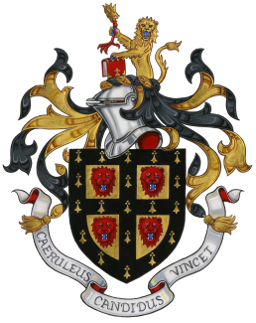
The Cambridge University Heraldic & Genealogical Society

| 1. |  Isabel Dyneley was christened on 3 Jan. 1636/37 in Otley, Yorkshire, England (daughter of Robert Dyneley and Margaret Stanhope); was buried on 11 Feb. 1672. Isabel Dyneley was christened on 3 Jan. 1636/37 in Otley, Yorkshire, England (daughter of Robert Dyneley and Margaret Stanhope); was buried on 11 Feb. 1672. |
| 2. |  Robert Dyneley was christened on 20 Aug. 1607 in Otley, Yorkshire, England (son of Sir Robert Dyneley and Olive Stapylton); died on 11 Nov. 1688; was buried on 14 Nov. 1688 in Otley, Yorkshire, England. Robert Dyneley was christened on 20 Aug. 1607 in Otley, Yorkshire, England (son of Sir Robert Dyneley and Olive Stapylton); died on 11 Nov. 1688; was buried on 14 Nov. 1688 in Otley, Yorkshire, England. Other Events:
Notes: He built, in conjunction with other freeholders, the chapel at Bramhope, under a deed dated 1649. Robert married Margaret Stanhope on 24 Jan. 1628/29 in Hooton Pagnell, Yorkshire, England. Margaret (daughter of Sir John Stanhope) was christened on 25 March 1607. [Group Sheet] [Family Chart] |
| 3. | Margaret Stanhope was christened on 25 March 1607 (daughter of Sir John Stanhope). Notes: College of Arms MS. Norfolk 4 and Joseph Foster, Pedigrees of the County Families of Yorkshire (1874), both state that Robert Dyneley and Margaret Stanhope had a daughter named Elizabeth, baptized 1669, and that she married William Pearson. William Pearson was in fact the husband of Margaret Dyneley (another daughter of Robert Dyneley and Margaret Stanhope). Elizabeth's putative baptism had been conflated with that of her niece, Elizabeth, the daughter of Robert Dyneley and Dorcas Mauleverer. There is no record of an Elizabeth having been baptized at Otley in the 1630s and 1640s. There is no primary evidence that Robert Dyneley and Margaret Stanhope had a daughter named Elizabeth, and she has accordingly been omitted from this genealogy.
|
| 4. |  Sir Robert Dyneley was born circa 1578 (son of John Dyneley and Ellen Hopton); was buried on 8 Feb. 1616/17 in Otley, Yorkshire, England. Sir Robert Dyneley was born circa 1578 (son of John Dyneley and Ellen Hopton); was buried on 8 Feb. 1616/17 in Otley, Yorkshire, England. Other Events:
Notes: Decoration: Robert married Olive Stapylton on 25 June 1605 in St. Luke's, Chelsea, Middlesex, England. Olive (daughter of Sir Robert Stapylton and Olive Sherrington) was christened on 18 May 1586 in Lacock, Wiltshire, England; was buried on 5 June 1656 in Otley, Yorkshire, England. [Group Sheet] [Family Chart] |
| 5. |  Olive Stapylton was christened on 18 May 1586 in Lacock, Wiltshire, England (daughter of Sir Robert Stapylton and Olive Sherrington); was buried on 5 June 1656 in Otley, Yorkshire, England. Olive Stapylton was christened on 18 May 1586 in Lacock, Wiltshire, England (daughter of Sir Robert Stapylton and Olive Sherrington); was buried on 5 June 1656 in Otley, Yorkshire, England.
|
| 6. | Sir John Stanhope Other Events:
Notes: The compiler of College of Arms MS. Norfolk 4, page 141, was uncertain as to the county in which Sir John Stanhope's abode of "Melford" was located. The entry reads: "Margaret daughter of Sir John Stanhope of Melford in Com: . . . . . . . . Knight" [sic]. "The Bradford Antiquary, The Journal of the Bradford Historical and Antiquarian Society," New Series, volume I. (Bradford, 1900), page 326, identified the place as "Melford, Kent." It is noted, however, that Joseph Hunter, "Familiae Minorum Gentium," volume 3, pages 988-9, identified the father of Margaret Stanhope (the wife of Robert Dyneley) as "Sir John Stanhope of Stotfold in psh. of Hooton Paynel, & of Melwood Park in the Isle of Axholme." Perhaps "Melford" was therefore an error, and ought to read "Melwood."
|
| 8. |  John Dyneley (son of William Dyneley and Margerie Ellys); was buried on 22 Dec. 1606 in Otley, Yorkshire, England. John Dyneley (son of William Dyneley and Margerie Ellys); was buried on 22 Dec. 1606 in Otley, Yorkshire, England. Other Events:
John married Ellen Hopton. Ellen (daughter of Christopher Hopton and Margaret Danby) was buried on 28 Nov. 1588 in Otley, Yorkshire, England. [Group Sheet] [Family Chart] |
| 9. |  Ellen Hopton (daughter of Christopher Hopton and Margaret Danby); was buried on 28 Nov. 1588 in Otley, Yorkshire, England. Ellen Hopton (daughter of Christopher Hopton and Margaret Danby); was buried on 28 Nov. 1588 in Otley, Yorkshire, England.
|
| 10. |  Sir Robert Stapylton was born circa 1548; was buried on 3 Oct. 1606 in Wighill, Yorkshire, England. Sir Robert Stapylton was born circa 1548; was buried on 3 Oct. 1606 in Wighill, Yorkshire, England. Other Events:
Notes: He built a new house at Wighill about 1580. Robert married Olive Sherrington. Olive (daughter of Sir Henry Sherrington) died in 1646; was buried in Lacock, Wiltshire, England. [Group Sheet] [Family Chart] |
| 11. | Olive Sherrington (daughter of Sir Henry Sherrington); died in 1646; was buried in Lacock, Wiltshire, England. Other Events:
|
This site is powered by The Next Generation of Genealogy Sitebuilding v. 13.0.3, written by Darrin Lythgoe © 2001-2024.
Maintained by the Cambridge University Heraldic & Genealogical Society.
Copyright © 2023 All rights reserved.